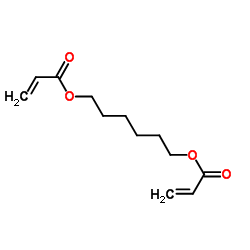1,6-Hexanediyl bisacrylate

1,6-Hexanediyl bisacrylate structure
|
Common Name | 1,6-Hexanediyl bisacrylate | ||
|---|---|---|---|---|
| CAS Number | 13048-33-4 | Molecular Weight | 226.269 | |
| Density | 1.0±0.1 g/cm3 | Boiling Point | 302.1±25.0 °C at 760 mmHg | |
| Molecular Formula | C12H18O4 | Melting Point | 6°C | |
| MSDS | Chinese USA | Flash Point | 142.3±21.6 °C | |
| Symbol |

GHS07 |
Signal Word | Warning | |
|
Photopatterned oil-reservoir micromodels with tailored wetting properties.
Lab Chip 15 , 3047-55, (2015) Micromodels with a simplified porous network that represents geological porous media have been used as experimental test beds for multiphase flow studies in the petroleum industry. We present a new method to fabricate reservoir micromodels with heterogeneous ... |
|
|
Solid-phase synthesis of a modified 13-residue seminalplasmin fragment on 1,6-hexanediol diacrylate-crosslinked polystyrene support.
Peptides 21(6) , 773-7, (2000) A novel 1,6-hexanediol diacrylate cross-linked resin was prepared that was subsequently functionalized by using chloromethyl methyl ether to afford a high-capacity resin. The resin exhibited good swelling and its application in the successful synthesis of a 1... |
|
|
Permeation of multifunctional acrylates through selected protective glove materials.
Am. Ind. Hyg. Assoc. J. 53(2) , 117-23, (1992) In support of the Premanufacture Notification (PMN) program of the Environmental Protection Agency's Office of Toxic Substances, the resistance of three glove materials to permeation by multifunctional acrylate compounds was evaluated through a program for th... |
|
|
Spontaneous Pattern Formation of Surface Nanodroplets from Competitive Growth.
ACS Nano 9 , 11916-23, (2015) Nanoscale droplets on a substrate are of great interest because of their relevance for droplet-based technologies for light manipulation, lab-on-chip devices, miniaturized reactors, encapsulation, and many others. In this work, we establish a basic principle ... |
|
|
Stabilization of polyplexes via polymer crosslinking for efficient siRNA delivery.
Eur. J. Pharm. Sci. 47(5) , 914-20, (2012) The pseudodendritic, biodegradable polymer HD-O, consisting of an OEI800 core with several OEI800 molecules attached to it via 1.6-hexanediol diacrylate linkers, has potent pDNA but poor siRNA delivery ability, due to instability of the resulting siRNA polypl... |
|
|
[Irritation and allergy to acrylates and methacrylates. - Part II: Polyfunctional acrylic monomers (author's transl)].
Ann. Dermatol. Venereol. 108(6-7) , 559-66, (1981) Acrylates and methacrylates are industrial chemicals with insufficiently known irritating and allergic effects. After considering simples monoacrylates and monomethacrylates, this paper deals with the n-ethyleneglycol acrylates and methacrylates and some poly... |
|
|
Solid phase synthesis of hydrophobic peptides on 1,6-hexanediol diacrylate cross-linked polystyrene resin.
J. Pept. Sci. 5(12) , 577-81, (1999) The synthesis of three hydrophobic peptides, which are partial sequences of thioredoxin, on a newly developed, flexible 1,6-hexanediol diacrylate cross-linked polystyrene, in good yield and purity, is described. |
|
|
Disposable fluorescence optical pH sensor for near neutral solutions.
Sensors (Basel.) 13 , 484-99, (2012) The design, development and performance evaluation of a fluorescence-based pH sensor for on-line measurements is presented. The pKa of the sensing element has been calculated to be 7.9, thus the sensor is suitable for measurement of near neutral solutions. Th... |
|
|
Multiresponse strategies to modulate burst degradation and release from nanoparticles.
ACS Nano 4 , 5930-6, (2010) Logic gate nanoparticles, where two chemical transformations take place one after the other, were successfully formulated from a newly synthesized random co-polymer. This polymer, poly([2,2'-(propane-2,2-diylbis(oxy))bis(ethane-2,1-diyl) diacrylate ]-co-[hexa... |
|
|
Allergic contact dermatitis due to urethane acrylate in ultraviolet cured inks.
Br. J. Ind. Med. 40(3) , 241-50, (1983) Seven workers exposed to ultraviolet printing inks developed contact dermatitis. Six cases were allergic and one irritant. A urethane acrylate resin accounted for five cases of sensitisation, one of which was also sensitive to pentaerythritol triacrylate and ... |